Uterine Fibroid Control & Management: Nursing, Team, and Patient Care
VerifiedAdded on 2020/03/01
|10
|2730
|14
Report
AI Summary
This report delves into the multifaceted aspects of uterine fibroid control and management, beginning with an exploration of the etiology and pathophysiology of leiomyomas, emphasizing the role of genetic changes, hormones, and growth factors. It then examines the patient's post-operative deterioration, specifically hypovolemic shock, and the associated nursing management strategies, including securing the airway, arresting bleeding, and fluid resuscitation. The report further details the interdisciplinary healthcare team's roles, including the social worker, physical and occupational therapists, and the family, in providing comprehensive patient care. The nursing management section covers the importance of rapid diagnosis, vital-sign stabilization, and blood replacement, along with drug therapies to support blood pressure and interventions to address potential hemorrhage. The report emphasizes the need for a multidisciplinary approach to ensure optimal patient outcomes and highlights the significance of each team member's contributions to the patient's physical and emotional well-being, providing a holistic perspective on uterine fibroid management.

Running Head: UTERINE FIBROID CONTROL & MANAGEMENT
Uterine Fibroid Control & Management
Name
Institution and Affiliations
Instructor:
Date:
Uterine Fibroid Control & Management
Name
Institution and Affiliations
Instructor:
Date:
Paraphrase This Document
Need a fresh take? Get an instant paraphrase of this document with our AI Paraphraser
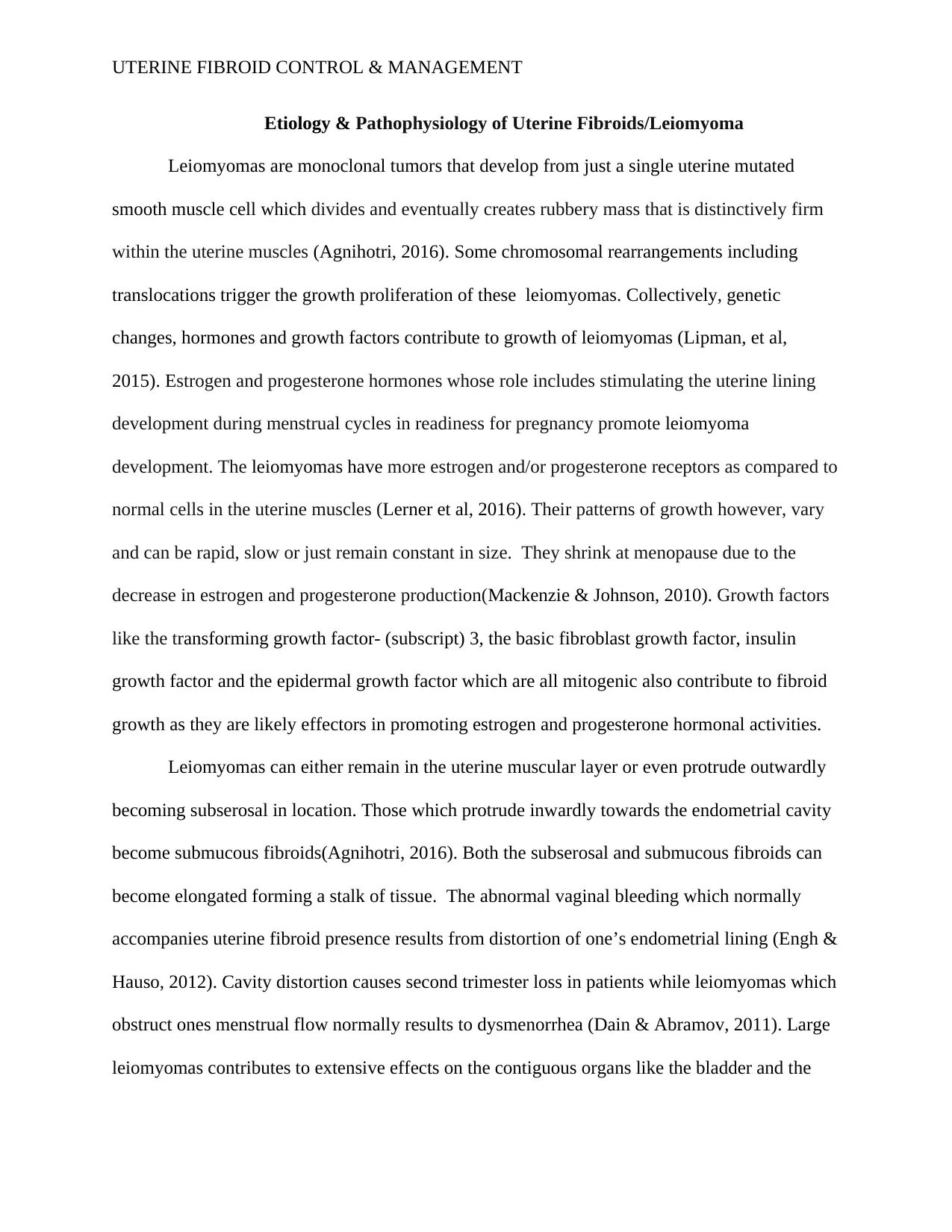
UTERINE FIBROID CONTROL & MANAGEMENT
Etiology & Pathophysiology of Uterine Fibroids/Leiomyoma
Leiomyomas are monoclonal tumors that develop from just a single uterine mutated
smooth muscle cell which divides and eventually creates rubbery mass that is distinctively firm
within the uterine muscles (Agnihotri, 2016). Some chromosomal rearrangements including
translocations trigger the growth proliferation of these leiomyomas. Collectively, genetic
changes, hormones and growth factors contribute to growth of leiomyomas (Lipman, et al,
2015). Estrogen and progesterone hormones whose role includes stimulating the uterine lining
development during menstrual cycles in readiness for pregnancy promote leiomyoma
development. The leiomyomas have more estrogen and/or progesterone receptors as compared to
normal cells in the uterine muscles (Lerner et al, 2016). Their patterns of growth however, vary
and can be rapid, slow or just remain constant in size. They shrink at menopause due to the
decrease in estrogen and progesterone production(Mackenzie & Johnson, 2010). Growth factors
like the transforming growth factor- (subscript) 3, the basic fibroblast growth factor, insulin
growth factor and the epidermal growth factor which are all mitogenic also contribute to fibroid
growth as they are likely effectors in promoting estrogen and progesterone hormonal activities.
Leiomyomas can either remain in the uterine muscular layer or even protrude outwardly
becoming subserosal in location. Those which protrude inwardly towards the endometrial cavity
become submucous fibroids(Agnihotri, 2016). Both the subserosal and submucous fibroids can
become elongated forming a stalk of tissue. The abnormal vaginal bleeding which normally
accompanies uterine fibroid presence results from distortion of one’s endometrial lining (Engh &
Hauso, 2012). Cavity distortion causes second trimester loss in patients while leiomyomas which
obstruct ones menstrual flow normally results to dysmenorrhea (Dain & Abramov, 2011). Large
leiomyomas contributes to extensive effects on the contiguous organs like the bladder and the
Etiology & Pathophysiology of Uterine Fibroids/Leiomyoma
Leiomyomas are monoclonal tumors that develop from just a single uterine mutated
smooth muscle cell which divides and eventually creates rubbery mass that is distinctively firm
within the uterine muscles (Agnihotri, 2016). Some chromosomal rearrangements including
translocations trigger the growth proliferation of these leiomyomas. Collectively, genetic
changes, hormones and growth factors contribute to growth of leiomyomas (Lipman, et al,
2015). Estrogen and progesterone hormones whose role includes stimulating the uterine lining
development during menstrual cycles in readiness for pregnancy promote leiomyoma
development. The leiomyomas have more estrogen and/or progesterone receptors as compared to
normal cells in the uterine muscles (Lerner et al, 2016). Their patterns of growth however, vary
and can be rapid, slow or just remain constant in size. They shrink at menopause due to the
decrease in estrogen and progesterone production(Mackenzie & Johnson, 2010). Growth factors
like the transforming growth factor- (subscript) 3, the basic fibroblast growth factor, insulin
growth factor and the epidermal growth factor which are all mitogenic also contribute to fibroid
growth as they are likely effectors in promoting estrogen and progesterone hormonal activities.
Leiomyomas can either remain in the uterine muscular layer or even protrude outwardly
becoming subserosal in location. Those which protrude inwardly towards the endometrial cavity
become submucous fibroids(Agnihotri, 2016). Both the subserosal and submucous fibroids can
become elongated forming a stalk of tissue. The abnormal vaginal bleeding which normally
accompanies uterine fibroid presence results from distortion of one’s endometrial lining (Engh &
Hauso, 2012). Cavity distortion causes second trimester loss in patients while leiomyomas which
obstruct ones menstrual flow normally results to dysmenorrhea (Dain & Abramov, 2011). Large
leiomyomas contributes to extensive effects on the contiguous organs like the bladder and the
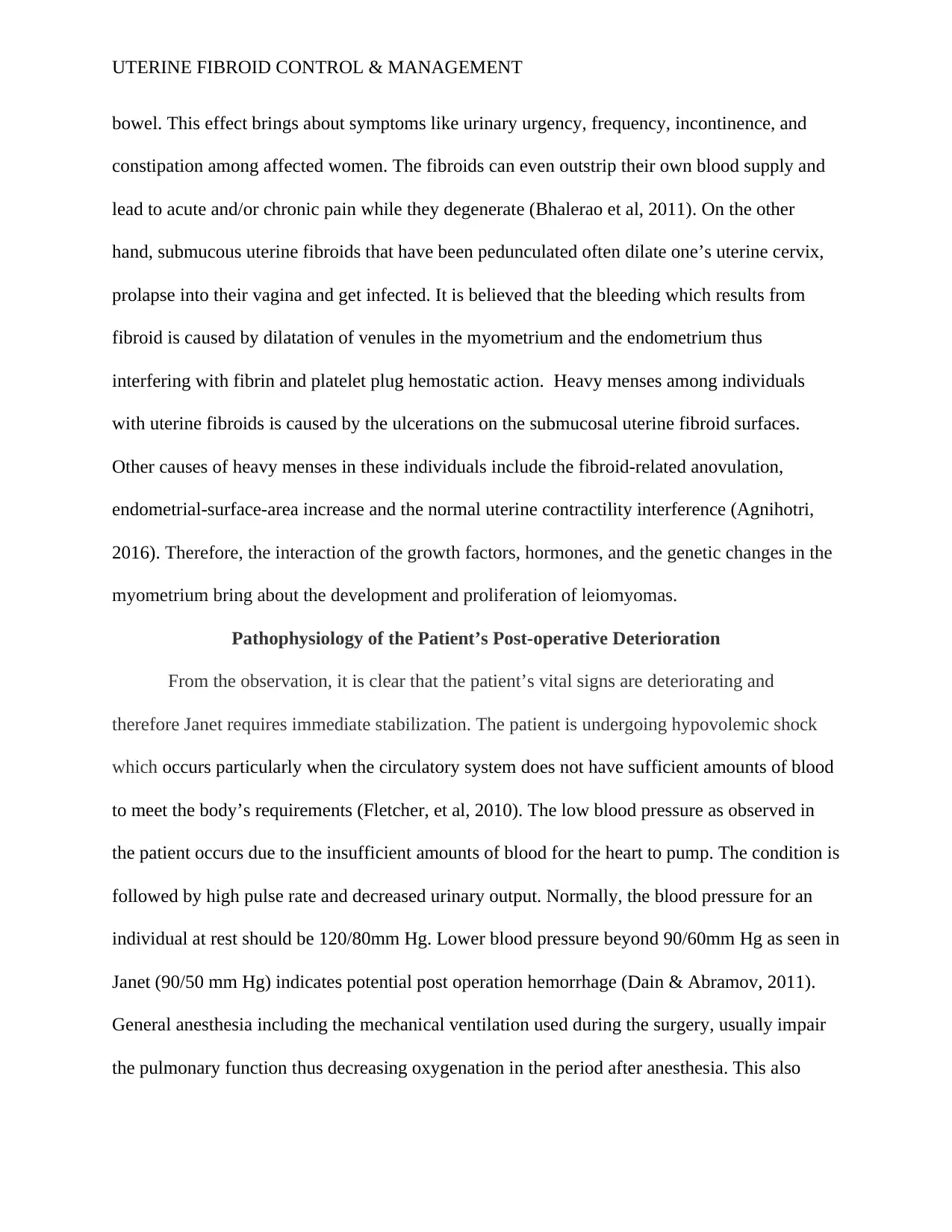
UTERINE FIBROID CONTROL & MANAGEMENT
bowel. This effect brings about symptoms like urinary urgency, frequency, incontinence, and
constipation among affected women. The fibroids can even outstrip their own blood supply and
lead to acute and/or chronic pain while they degenerate (Bhalerao et al, 2011). On the other
hand, submucous uterine fibroids that have been pedunculated often dilate one’s uterine cervix,
prolapse into their vagina and get infected. It is believed that the bleeding which results from
fibroid is caused by dilatation of venules in the myometrium and the endometrium thus
interfering with fibrin and platelet plug hemostatic action. Heavy menses among individuals
with uterine fibroids is caused by the ulcerations on the submucosal uterine fibroid surfaces.
Other causes of heavy menses in these individuals include the fibroid-related anovulation,
endometrial-surface-area increase and the normal uterine contractility interference (Agnihotri,
2016). Therefore, the interaction of the growth factors, hormones, and the genetic changes in the
myometrium bring about the development and proliferation of leiomyomas.
Pathophysiology of the Patient’s Post-operative Deterioration
From the observation, it is clear that the patient’s vital signs are deteriorating and
therefore Janet requires immediate stabilization. The patient is undergoing hypovolemic shock
which occurs particularly when the circulatory system does not have sufficient amounts of blood
to meet the body’s requirements (Fletcher, et al, 2010). The low blood pressure as observed in
the patient occurs due to the insufficient amounts of blood for the heart to pump. The condition is
followed by high pulse rate and decreased urinary output. Normally, the blood pressure for an
individual at rest should be 120/80mm Hg. Lower blood pressure beyond 90/60mm Hg as seen in
Janet (90/50 mm Hg) indicates potential post operation hemorrhage (Dain & Abramov, 2011).
General anesthesia including the mechanical ventilation used during the surgery, usually impair
the pulmonary function thus decreasing oxygenation in the period after anesthesia. This also
bowel. This effect brings about symptoms like urinary urgency, frequency, incontinence, and
constipation among affected women. The fibroids can even outstrip their own blood supply and
lead to acute and/or chronic pain while they degenerate (Bhalerao et al, 2011). On the other
hand, submucous uterine fibroids that have been pedunculated often dilate one’s uterine cervix,
prolapse into their vagina and get infected. It is believed that the bleeding which results from
fibroid is caused by dilatation of venules in the myometrium and the endometrium thus
interfering with fibrin and platelet plug hemostatic action. Heavy menses among individuals
with uterine fibroids is caused by the ulcerations on the submucosal uterine fibroid surfaces.
Other causes of heavy menses in these individuals include the fibroid-related anovulation,
endometrial-surface-area increase and the normal uterine contractility interference (Agnihotri,
2016). Therefore, the interaction of the growth factors, hormones, and the genetic changes in the
myometrium bring about the development and proliferation of leiomyomas.
Pathophysiology of the Patient’s Post-operative Deterioration
From the observation, it is clear that the patient’s vital signs are deteriorating and
therefore Janet requires immediate stabilization. The patient is undergoing hypovolemic shock
which occurs particularly when the circulatory system does not have sufficient amounts of blood
to meet the body’s requirements (Fletcher, et al, 2010). The low blood pressure as observed in
the patient occurs due to the insufficient amounts of blood for the heart to pump. The condition is
followed by high pulse rate and decreased urinary output. Normally, the blood pressure for an
individual at rest should be 120/80mm Hg. Lower blood pressure beyond 90/60mm Hg as seen in
Janet (90/50 mm Hg) indicates potential post operation hemorrhage (Dain & Abramov, 2011).
General anesthesia including the mechanical ventilation used during the surgery, usually impair
the pulmonary function thus decreasing oxygenation in the period after anesthesia. This also
⊘ This is a preview!⊘
Do you want full access?
Subscribe today to unlock all pages.

Trusted by 1+ million students worldwide
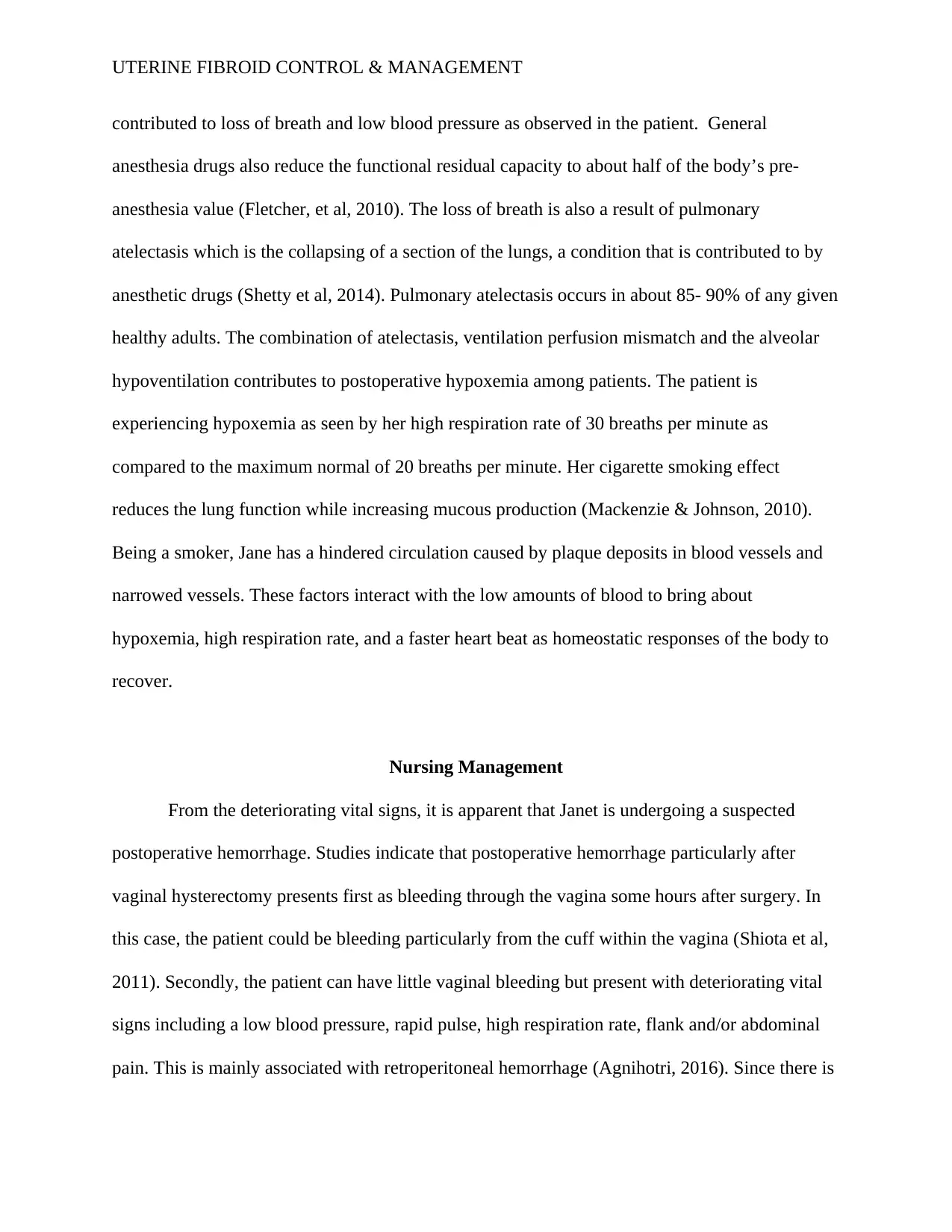
UTERINE FIBROID CONTROL & MANAGEMENT
contributed to loss of breath and low blood pressure as observed in the patient. General
anesthesia drugs also reduce the functional residual capacity to about half of the body’s pre-
anesthesia value (Fletcher, et al, 2010). The loss of breath is also a result of pulmonary
atelectasis which is the collapsing of a section of the lungs, a condition that is contributed to by
anesthetic drugs (Shetty et al, 2014). Pulmonary atelectasis occurs in about 85- 90% of any given
healthy adults. The combination of atelectasis, ventilation perfusion mismatch and the alveolar
hypoventilation contributes to postoperative hypoxemia among patients. The patient is
experiencing hypoxemia as seen by her high respiration rate of 30 breaths per minute as
compared to the maximum normal of 20 breaths per minute. Her cigarette smoking effect
reduces the lung function while increasing mucous production (Mackenzie & Johnson, 2010).
Being a smoker, Jane has a hindered circulation caused by plaque deposits in blood vessels and
narrowed vessels. These factors interact with the low amounts of blood to bring about
hypoxemia, high respiration rate, and a faster heart beat as homeostatic responses of the body to
recover.
Nursing Management
From the deteriorating vital signs, it is apparent that Janet is undergoing a suspected
postoperative hemorrhage. Studies indicate that postoperative hemorrhage particularly after
vaginal hysterectomy presents first as bleeding through the vagina some hours after surgery. In
this case, the patient could be bleeding particularly from the cuff within the vagina (Shiota et al,
2011). Secondly, the patient can have little vaginal bleeding but present with deteriorating vital
signs including a low blood pressure, rapid pulse, high respiration rate, flank and/or abdominal
pain. This is mainly associated with retroperitoneal hemorrhage (Agnihotri, 2016). Since there is
contributed to loss of breath and low blood pressure as observed in the patient. General
anesthesia drugs also reduce the functional residual capacity to about half of the body’s pre-
anesthesia value (Fletcher, et al, 2010). The loss of breath is also a result of pulmonary
atelectasis which is the collapsing of a section of the lungs, a condition that is contributed to by
anesthetic drugs (Shetty et al, 2014). Pulmonary atelectasis occurs in about 85- 90% of any given
healthy adults. The combination of atelectasis, ventilation perfusion mismatch and the alveolar
hypoventilation contributes to postoperative hypoxemia among patients. The patient is
experiencing hypoxemia as seen by her high respiration rate of 30 breaths per minute as
compared to the maximum normal of 20 breaths per minute. Her cigarette smoking effect
reduces the lung function while increasing mucous production (Mackenzie & Johnson, 2010).
Being a smoker, Jane has a hindered circulation caused by plaque deposits in blood vessels and
narrowed vessels. These factors interact with the low amounts of blood to bring about
hypoxemia, high respiration rate, and a faster heart beat as homeostatic responses of the body to
recover.
Nursing Management
From the deteriorating vital signs, it is apparent that Janet is undergoing a suspected
postoperative hemorrhage. Studies indicate that postoperative hemorrhage particularly after
vaginal hysterectomy presents first as bleeding through the vagina some hours after surgery. In
this case, the patient could be bleeding particularly from the cuff within the vagina (Shiota et al,
2011). Secondly, the patient can have little vaginal bleeding but present with deteriorating vital
signs including a low blood pressure, rapid pulse, high respiration rate, flank and/or abdominal
pain. This is mainly associated with retroperitoneal hemorrhage (Agnihotri, 2016). Since there is
Paraphrase This Document
Need a fresh take? Get an instant paraphrase of this document with our AI Paraphraser
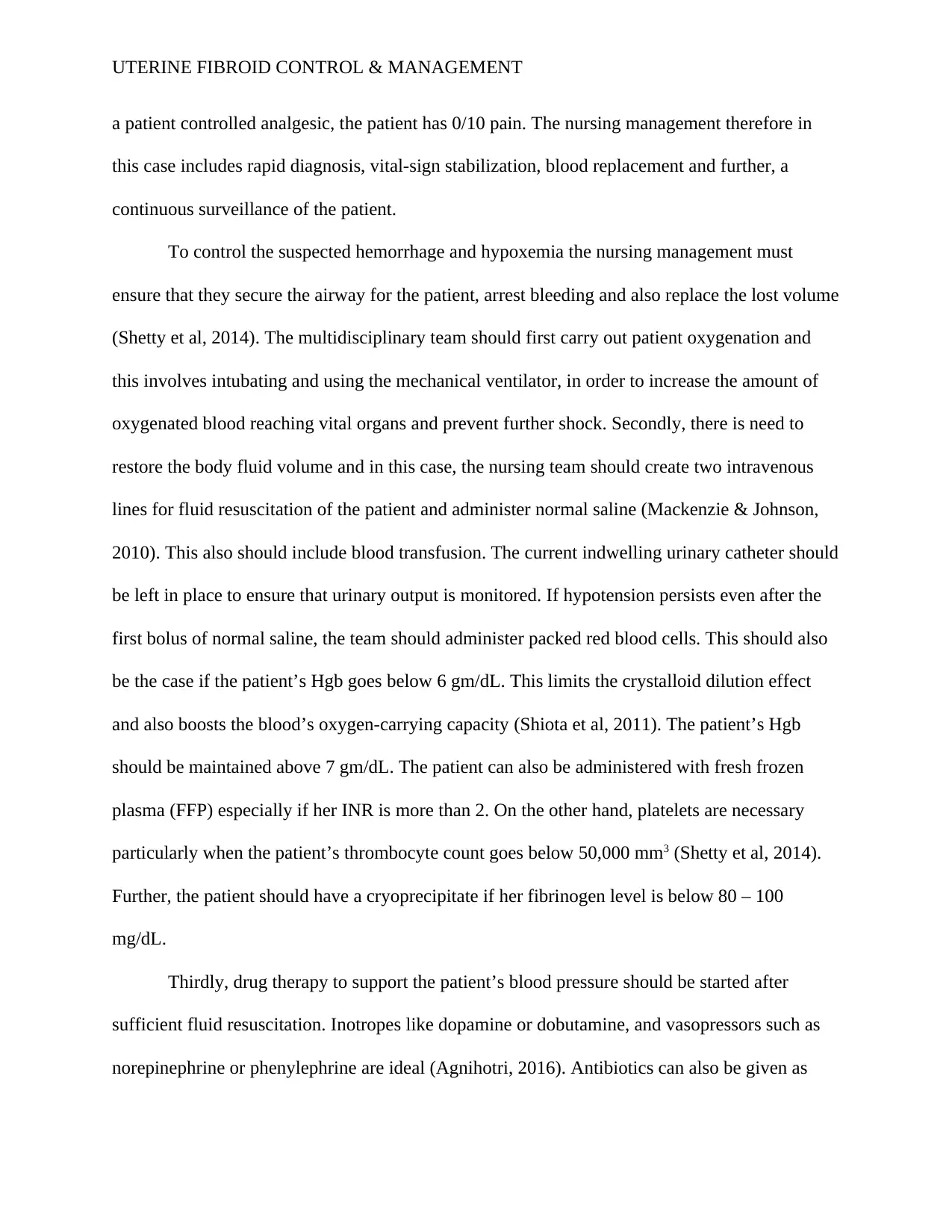
UTERINE FIBROID CONTROL & MANAGEMENT
a patient controlled analgesic, the patient has 0/10 pain. The nursing management therefore in
this case includes rapid diagnosis, vital-sign stabilization, blood replacement and further, a
continuous surveillance of the patient.
To control the suspected hemorrhage and hypoxemia the nursing management must
ensure that they secure the airway for the patient, arrest bleeding and also replace the lost volume
(Shetty et al, 2014). The multidisciplinary team should first carry out patient oxygenation and
this involves intubating and using the mechanical ventilator, in order to increase the amount of
oxygenated blood reaching vital organs and prevent further shock. Secondly, there is need to
restore the body fluid volume and in this case, the nursing team should create two intravenous
lines for fluid resuscitation of the patient and administer normal saline (Mackenzie & Johnson,
2010). This also should include blood transfusion. The current indwelling urinary catheter should
be left in place to ensure that urinary output is monitored. If hypotension persists even after the
first bolus of normal saline, the team should administer packed red blood cells. This should also
be the case if the patient’s Hgb goes below 6 gm/dL. This limits the crystalloid dilution effect
and also boosts the blood’s oxygen-carrying capacity (Shiota et al, 2011). The patient’s Hgb
should be maintained above 7 gm/dL. The patient can also be administered with fresh frozen
plasma (FFP) especially if her INR is more than 2. On the other hand, platelets are necessary
particularly when the patient’s thrombocyte count goes below 50,000 mm3 (Shetty et al, 2014).
Further, the patient should have a cryoprecipitate if her fibrinogen level is below 80 – 100
mg/dL.
Thirdly, drug therapy to support the patient’s blood pressure should be started after
sufficient fluid resuscitation. Inotropes like dopamine or dobutamine, and vasopressors such as
norepinephrine or phenylephrine are ideal (Agnihotri, 2016). Antibiotics can also be given as
a patient controlled analgesic, the patient has 0/10 pain. The nursing management therefore in
this case includes rapid diagnosis, vital-sign stabilization, blood replacement and further, a
continuous surveillance of the patient.
To control the suspected hemorrhage and hypoxemia the nursing management must
ensure that they secure the airway for the patient, arrest bleeding and also replace the lost volume
(Shetty et al, 2014). The multidisciplinary team should first carry out patient oxygenation and
this involves intubating and using the mechanical ventilator, in order to increase the amount of
oxygenated blood reaching vital organs and prevent further shock. Secondly, there is need to
restore the body fluid volume and in this case, the nursing team should create two intravenous
lines for fluid resuscitation of the patient and administer normal saline (Mackenzie & Johnson,
2010). This also should include blood transfusion. The current indwelling urinary catheter should
be left in place to ensure that urinary output is monitored. If hypotension persists even after the
first bolus of normal saline, the team should administer packed red blood cells. This should also
be the case if the patient’s Hgb goes below 6 gm/dL. This limits the crystalloid dilution effect
and also boosts the blood’s oxygen-carrying capacity (Shiota et al, 2011). The patient’s Hgb
should be maintained above 7 gm/dL. The patient can also be administered with fresh frozen
plasma (FFP) especially if her INR is more than 2. On the other hand, platelets are necessary
particularly when the patient’s thrombocyte count goes below 50,000 mm3 (Shetty et al, 2014).
Further, the patient should have a cryoprecipitate if her fibrinogen level is below 80 – 100
mg/dL.
Thirdly, drug therapy to support the patient’s blood pressure should be started after
sufficient fluid resuscitation. Inotropes like dopamine or dobutamine, and vasopressors such as
norepinephrine or phenylephrine are ideal (Agnihotri, 2016). Antibiotics can also be given as
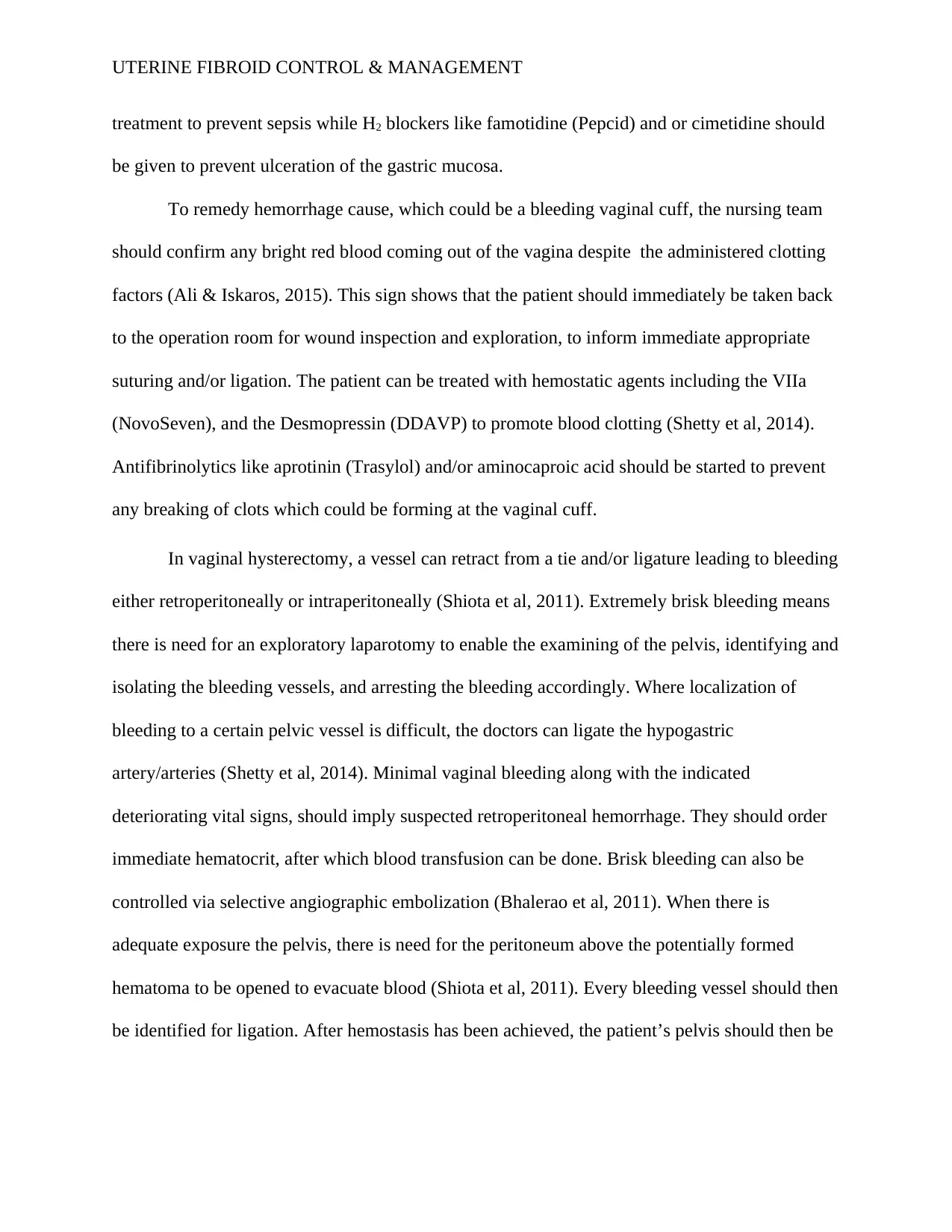
UTERINE FIBROID CONTROL & MANAGEMENT
treatment to prevent sepsis while H2 blockers like famotidine (Pepcid) and or cimetidine should
be given to prevent ulceration of the gastric mucosa.
To remedy hemorrhage cause, which could be a bleeding vaginal cuff, the nursing team
should confirm any bright red blood coming out of the vagina despite the administered clotting
factors (Ali & Iskaros, 2015). This sign shows that the patient should immediately be taken back
to the operation room for wound inspection and exploration, to inform immediate appropriate
suturing and/or ligation. The patient can be treated with hemostatic agents including the VIIa
(NovoSeven), and the Desmopressin (DDAVP) to promote blood clotting (Shetty et al, 2014).
Antifibrinolytics like aprotinin (Trasylol) and/or aminocaproic acid should be started to prevent
any breaking of clots which could be forming at the vaginal cuff.
In vaginal hysterectomy, a vessel can retract from a tie and/or ligature leading to bleeding
either retroperitoneally or intraperitoneally (Shiota et al, 2011). Extremely brisk bleeding means
there is need for an exploratory laparotomy to enable the examining of the pelvis, identifying and
isolating the bleeding vessels, and arresting the bleeding accordingly. Where localization of
bleeding to a certain pelvic vessel is difficult, the doctors can ligate the hypogastric
artery/arteries (Shetty et al, 2014). Minimal vaginal bleeding along with the indicated
deteriorating vital signs, should imply suspected retroperitoneal hemorrhage. They should order
immediate hematocrit, after which blood transfusion can be done. Brisk bleeding can also be
controlled via selective angiographic embolization (Bhalerao et al, 2011). When there is
adequate exposure the pelvis, there is need for the peritoneum above the potentially formed
hematoma to be opened to evacuate blood (Shiota et al, 2011). Every bleeding vessel should then
be identified for ligation. After hemostasis has been achieved, the patient’s pelvis should then be
treatment to prevent sepsis while H2 blockers like famotidine (Pepcid) and or cimetidine should
be given to prevent ulceration of the gastric mucosa.
To remedy hemorrhage cause, which could be a bleeding vaginal cuff, the nursing team
should confirm any bright red blood coming out of the vagina despite the administered clotting
factors (Ali & Iskaros, 2015). This sign shows that the patient should immediately be taken back
to the operation room for wound inspection and exploration, to inform immediate appropriate
suturing and/or ligation. The patient can be treated with hemostatic agents including the VIIa
(NovoSeven), and the Desmopressin (DDAVP) to promote blood clotting (Shetty et al, 2014).
Antifibrinolytics like aprotinin (Trasylol) and/or aminocaproic acid should be started to prevent
any breaking of clots which could be forming at the vaginal cuff.
In vaginal hysterectomy, a vessel can retract from a tie and/or ligature leading to bleeding
either retroperitoneally or intraperitoneally (Shiota et al, 2011). Extremely brisk bleeding means
there is need for an exploratory laparotomy to enable the examining of the pelvis, identifying and
isolating the bleeding vessels, and arresting the bleeding accordingly. Where localization of
bleeding to a certain pelvic vessel is difficult, the doctors can ligate the hypogastric
artery/arteries (Shetty et al, 2014). Minimal vaginal bleeding along with the indicated
deteriorating vital signs, should imply suspected retroperitoneal hemorrhage. They should order
immediate hematocrit, after which blood transfusion can be done. Brisk bleeding can also be
controlled via selective angiographic embolization (Bhalerao et al, 2011). When there is
adequate exposure the pelvis, there is need for the peritoneum above the potentially formed
hematoma to be opened to evacuate blood (Shiota et al, 2011). Every bleeding vessel should then
be identified for ligation. After hemostasis has been achieved, the patient’s pelvis should then be
⊘ This is a preview!⊘
Do you want full access?
Subscribe today to unlock all pages.

Trusted by 1+ million students worldwide
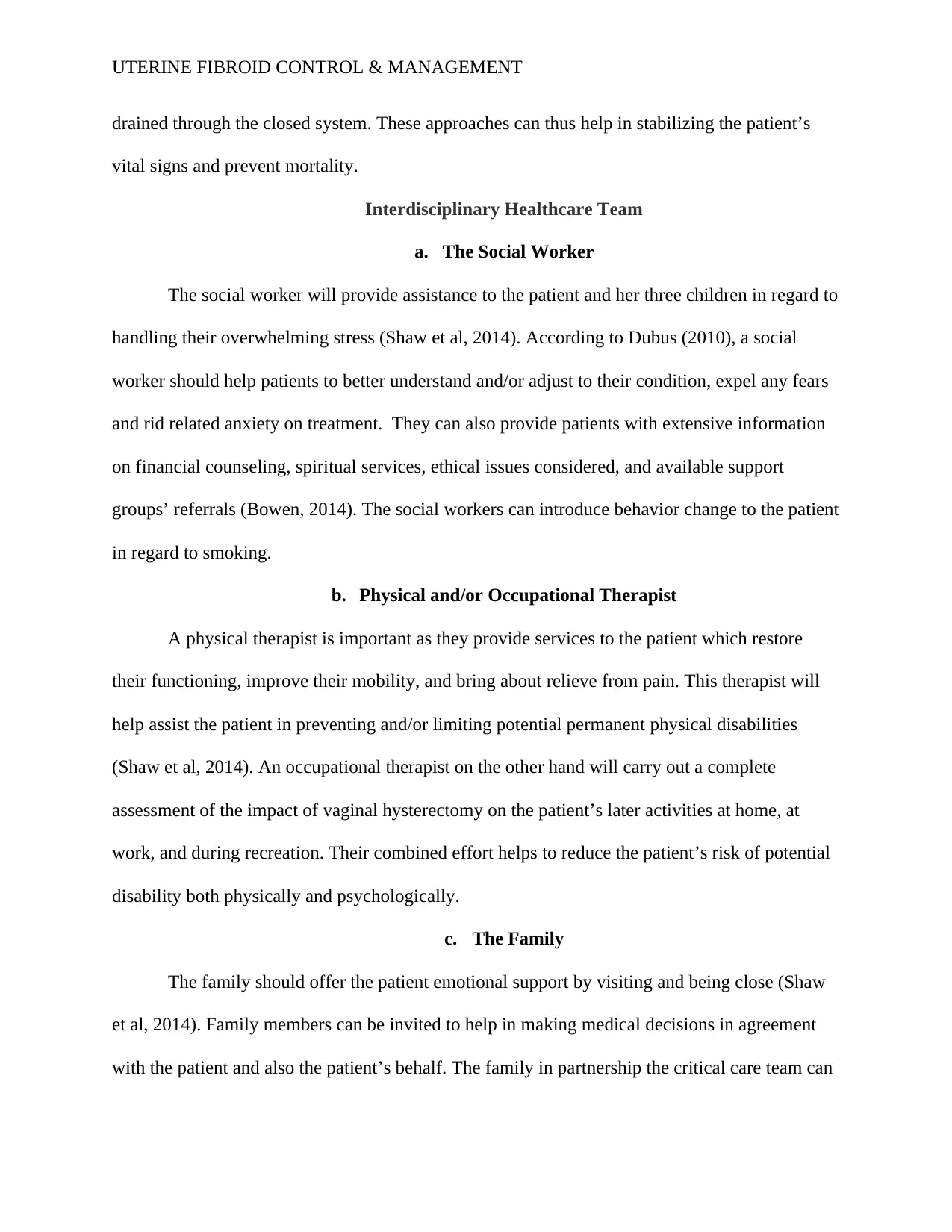
UTERINE FIBROID CONTROL & MANAGEMENT
drained through the closed system. These approaches can thus help in stabilizing the patient’s
vital signs and prevent mortality.
Interdisciplinary Healthcare Team
a. The Social Worker
The social worker will provide assistance to the patient and her three children in regard to
handling their overwhelming stress (Shaw et al, 2014). According to Dubus (2010), a social
worker should help patients to better understand and/or adjust to their condition, expel any fears
and rid related anxiety on treatment. They can also provide patients with extensive information
on financial counseling, spiritual services, ethical issues considered, and available support
groups’ referrals (Bowen, 2014). The social workers can introduce behavior change to the patient
in regard to smoking.
b. Physical and/or Occupational Therapist
A physical therapist is important as they provide services to the patient which restore
their functioning, improve their mobility, and bring about relieve from pain. This therapist will
help assist the patient in preventing and/or limiting potential permanent physical disabilities
(Shaw et al, 2014). An occupational therapist on the other hand will carry out a complete
assessment of the impact of vaginal hysterectomy on the patient’s later activities at home, at
work, and during recreation. Their combined effort helps to reduce the patient’s risk of potential
disability both physically and psychologically.
c. The Family
The family should offer the patient emotional support by visiting and being close (Shaw
et al, 2014). Family members can be invited to help in making medical decisions in agreement
with the patient and also the patient’s behalf. The family in partnership the critical care team can
drained through the closed system. These approaches can thus help in stabilizing the patient’s
vital signs and prevent mortality.
Interdisciplinary Healthcare Team
a. The Social Worker
The social worker will provide assistance to the patient and her three children in regard to
handling their overwhelming stress (Shaw et al, 2014). According to Dubus (2010), a social
worker should help patients to better understand and/or adjust to their condition, expel any fears
and rid related anxiety on treatment. They can also provide patients with extensive information
on financial counseling, spiritual services, ethical issues considered, and available support
groups’ referrals (Bowen, 2014). The social workers can introduce behavior change to the patient
in regard to smoking.
b. Physical and/or Occupational Therapist
A physical therapist is important as they provide services to the patient which restore
their functioning, improve their mobility, and bring about relieve from pain. This therapist will
help assist the patient in preventing and/or limiting potential permanent physical disabilities
(Shaw et al, 2014). An occupational therapist on the other hand will carry out a complete
assessment of the impact of vaginal hysterectomy on the patient’s later activities at home, at
work, and during recreation. Their combined effort helps to reduce the patient’s risk of potential
disability both physically and psychologically.
c. The Family
The family should offer the patient emotional support by visiting and being close (Shaw
et al, 2014). Family members can be invited to help in making medical decisions in agreement
with the patient and also the patient’s behalf. The family in partnership the critical care team can
Paraphrase This Document
Need a fresh take? Get an instant paraphrase of this document with our AI Paraphraser

UTERINE FIBROID CONTROL & MANAGEMENT
offer to share critical relevant crucial information regarding the patient for decision making
(Bowen, 2014). This can help inform on the possible financial support, referral groups among
other social factors that can promote the patient’s health post-operation.
offer to share critical relevant crucial information regarding the patient for decision making
(Bowen, 2014). This can help inform on the possible financial support, referral groups among
other social factors that can promote the patient’s health post-operation.
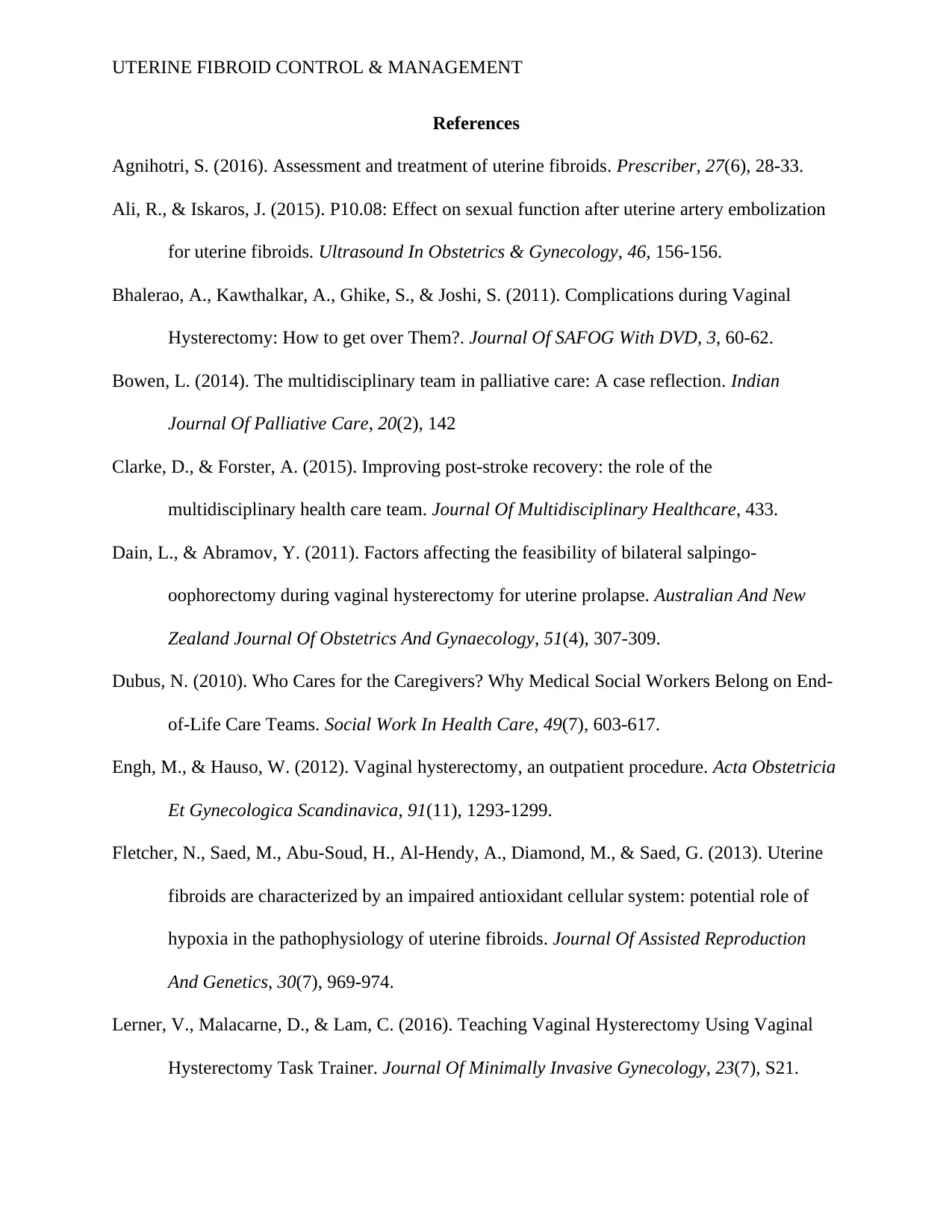
UTERINE FIBROID CONTROL & MANAGEMENT
References
Agnihotri, S. (2016). Assessment and treatment of uterine fibroids. Prescriber, 27(6), 28-33.
Ali, R., & Iskaros, J. (2015). P10.08: Effect on sexual function after uterine artery embolization
for uterine fibroids. Ultrasound In Obstetrics & Gynecology, 46, 156-156.
Bhalerao, A., Kawthalkar, A., Ghike, S., & Joshi, S. (2011). Complications during Vaginal
Hysterectomy: How to get over Them?. Journal Of SAFOG With DVD, 3, 60-62.
Bowen, L. (2014). The multidisciplinary team in palliative care: A case reflection. Indian
Journal Of Palliative Care, 20(2), 142
Clarke, D., & Forster, A. (2015). Improving post-stroke recovery: the role of the
multidisciplinary health care team. Journal Of Multidisciplinary Healthcare, 433.
Dain, L., & Abramov, Y. (2011). Factors affecting the feasibility of bilateral salpingo-
oophorectomy during vaginal hysterectomy for uterine prolapse. Australian And New
Zealand Journal Of Obstetrics And Gynaecology, 51(4), 307-309.
Dubus, N. (2010). Who Cares for the Caregivers? Why Medical Social Workers Belong on End-
of-Life Care Teams. Social Work In Health Care, 49(7), 603-617.
Engh, M., & Hauso, W. (2012). Vaginal hysterectomy, an outpatient procedure. Acta Obstetricia
Et Gynecologica Scandinavica, 91(11), 1293-1299.
Fletcher, N., Saed, M., Abu-Soud, H., Al-Hendy, A., Diamond, M., & Saed, G. (2013). Uterine
fibroids are characterized by an impaired antioxidant cellular system: potential role of
hypoxia in the pathophysiology of uterine fibroids. Journal Of Assisted Reproduction
And Genetics, 30(7), 969-974.
Lerner, V., Malacarne, D., & Lam, C. (2016). Teaching Vaginal Hysterectomy Using Vaginal
Hysterectomy Task Trainer. Journal Of Minimally Invasive Gynecology, 23(7), S21.
References
Agnihotri, S. (2016). Assessment and treatment of uterine fibroids. Prescriber, 27(6), 28-33.
Ali, R., & Iskaros, J. (2015). P10.08: Effect on sexual function after uterine artery embolization
for uterine fibroids. Ultrasound In Obstetrics & Gynecology, 46, 156-156.
Bhalerao, A., Kawthalkar, A., Ghike, S., & Joshi, S. (2011). Complications during Vaginal
Hysterectomy: How to get over Them?. Journal Of SAFOG With DVD, 3, 60-62.
Bowen, L. (2014). The multidisciplinary team in palliative care: A case reflection. Indian
Journal Of Palliative Care, 20(2), 142
Clarke, D., & Forster, A. (2015). Improving post-stroke recovery: the role of the
multidisciplinary health care team. Journal Of Multidisciplinary Healthcare, 433.
Dain, L., & Abramov, Y. (2011). Factors affecting the feasibility of bilateral salpingo-
oophorectomy during vaginal hysterectomy for uterine prolapse. Australian And New
Zealand Journal Of Obstetrics And Gynaecology, 51(4), 307-309.
Dubus, N. (2010). Who Cares for the Caregivers? Why Medical Social Workers Belong on End-
of-Life Care Teams. Social Work In Health Care, 49(7), 603-617.
Engh, M., & Hauso, W. (2012). Vaginal hysterectomy, an outpatient procedure. Acta Obstetricia
Et Gynecologica Scandinavica, 91(11), 1293-1299.
Fletcher, N., Saed, M., Abu-Soud, H., Al-Hendy, A., Diamond, M., & Saed, G. (2013). Uterine
fibroids are characterized by an impaired antioxidant cellular system: potential role of
hypoxia in the pathophysiology of uterine fibroids. Journal Of Assisted Reproduction
And Genetics, 30(7), 969-974.
Lerner, V., Malacarne, D., & Lam, C. (2016). Teaching Vaginal Hysterectomy Using Vaginal
Hysterectomy Task Trainer. Journal Of Minimally Invasive Gynecology, 23(7), S21.
⊘ This is a preview!⊘
Do you want full access?
Subscribe today to unlock all pages.

Trusted by 1+ million students worldwide
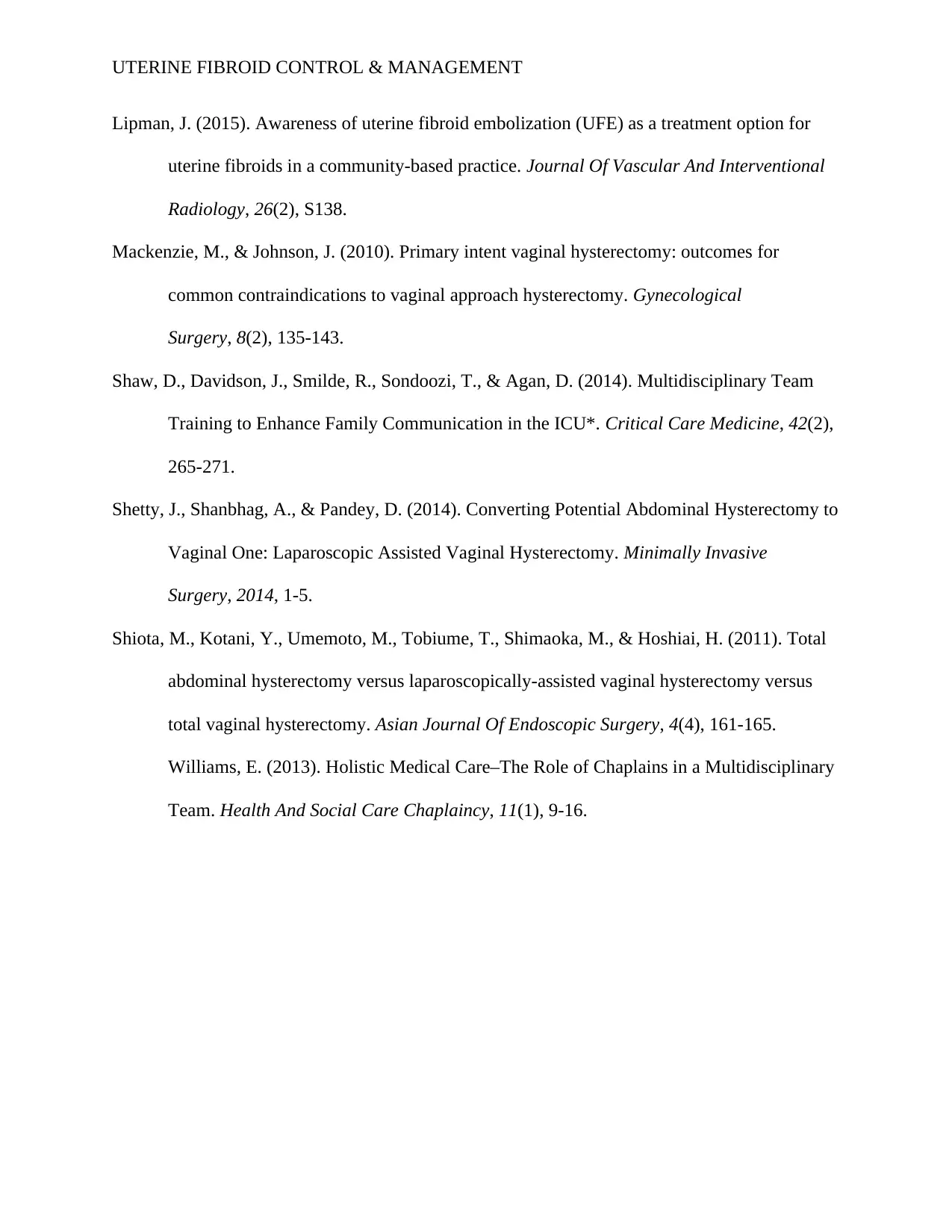
UTERINE FIBROID CONTROL & MANAGEMENT
Lipman, J. (2015). Awareness of uterine fibroid embolization (UFE) as a treatment option for
uterine fibroids in a community-based practice. Journal Of Vascular And Interventional
Radiology, 26(2), S138.
Mackenzie, M., & Johnson, J. (2010). Primary intent vaginal hysterectomy: outcomes for
common contraindications to vaginal approach hysterectomy. Gynecological
Surgery, 8(2), 135-143.
Shaw, D., Davidson, J., Smilde, R., Sondoozi, T., & Agan, D. (2014). Multidisciplinary Team
Training to Enhance Family Communication in the ICU*. Critical Care Medicine, 42(2),
265-271.
Shetty, J., Shanbhag, A., & Pandey, D. (2014). Converting Potential Abdominal Hysterectomy to
Vaginal One: Laparoscopic Assisted Vaginal Hysterectomy. Minimally Invasive
Surgery, 2014, 1-5.
Shiota, M., Kotani, Y., Umemoto, M., Tobiume, T., Shimaoka, M., & Hoshiai, H. (2011). Total
abdominal hysterectomy versus laparoscopically-assisted vaginal hysterectomy versus
total vaginal hysterectomy. Asian Journal Of Endoscopic Surgery, 4(4), 161-165.
Williams, E. (2013). Holistic Medical Care–The Role of Chaplains in a Multidisciplinary
Team. Health And Social Care Chaplaincy, 11(1), 9-16.
Lipman, J. (2015). Awareness of uterine fibroid embolization (UFE) as a treatment option for
uterine fibroids in a community-based practice. Journal Of Vascular And Interventional
Radiology, 26(2), S138.
Mackenzie, M., & Johnson, J. (2010). Primary intent vaginal hysterectomy: outcomes for
common contraindications to vaginal approach hysterectomy. Gynecological
Surgery, 8(2), 135-143.
Shaw, D., Davidson, J., Smilde, R., Sondoozi, T., & Agan, D. (2014). Multidisciplinary Team
Training to Enhance Family Communication in the ICU*. Critical Care Medicine, 42(2),
265-271.
Shetty, J., Shanbhag, A., & Pandey, D. (2014). Converting Potential Abdominal Hysterectomy to
Vaginal One: Laparoscopic Assisted Vaginal Hysterectomy. Minimally Invasive
Surgery, 2014, 1-5.
Shiota, M., Kotani, Y., Umemoto, M., Tobiume, T., Shimaoka, M., & Hoshiai, H. (2011). Total
abdominal hysterectomy versus laparoscopically-assisted vaginal hysterectomy versus
total vaginal hysterectomy. Asian Journal Of Endoscopic Surgery, 4(4), 161-165.
Williams, E. (2013). Holistic Medical Care–The Role of Chaplains in a Multidisciplinary
Team. Health And Social Care Chaplaincy, 11(1), 9-16.
1 out of 10
Related Documents
Your All-in-One AI-Powered Toolkit for Academic Success.
+13062052269
info@desklib.com
Available 24*7 on WhatsApp / Email
![[object Object]](/_next/static/media/star-bottom.7253800d.svg)
Unlock your academic potential
Copyright © 2020–2025 A2Z Services. All Rights Reserved. Developed and managed by ZUCOL.




